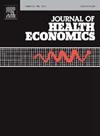Do for-profit hospitals cream-skim patients? Evidence from inpatient psychiatric care in California
IF 3.6
2区 经济学
Q1 ECONOMICS
引用次数: 0
Abstract
The paper examines whether, among inpatient psychiatric admissions in California, for-profit (FP) hospitals engage in cream skimming, i.e., selecting patients for some characteristic(s) other than their need for care, which enhances the profitability of the provider. We propose a novel approach to identifying cream skimming using cost outcomes. Naïve treatment effect estimates of hospital ownership type consist of the combined effects of differential patient case mix (selection) and hospital cost containment strategies (execution). In contrast, an instrumental variable (IV) approach can control for case mix and establish the causal effects of ownership type due to its execution. We interpret the difference between the naïve and IV treatment effects to be driven by FP hospitals’ selection based on unobserved patient case mix. Our findings on patient selection show that FP hospitals are more likely than their not-for-profit (NFP) counterparts to admit higher-cost patients (who tend to be less profitable under the existing inpatient psychiatric care payment systems), providing no evidence of cream skimming by FP hospitals. Furthermore, our estimates of hospital execution indicate that FP hospitals are more likely than NFP hospitals to deliver inpatient services at lower costs. These results may alleviate concerns about the recent proliferation of FP psychiatric hospitals, particularly regarding cream skimming in this market.
营利性医院会对病人进行奶油脱脂吗?来自加州住院精神病治疗的证据
本文考察了在加州的精神病住院患者中,营利性(FP)医院是否从事奶油撇脂,即选择患者的某些特征(s)而不是他们的护理需求,这提高了提供者的盈利能力。我们提出了一种利用成本结果来识别奶油撇脂的新方法。Naïve医院所有权类型的治疗效果估计包括不同患者病例组合(选择)和医院成本控制策略(执行)的综合效果。相比之下,工具变量(IV)方法可以控制案例组合并确定所有权类型因其执行而产生的因果效应。我们解释naïve和IV治疗效果之间的差异是由计划生育医院基于未观察到的患者病例组合的选择驱动的。我们对患者选择的研究结果表明,计划生育医院比非营利性医院更有可能接纳成本较高的患者(在现有的住院精神病护理支付系统下,这些患者往往利润较低),没有证据表明计划生育医院存在奶油脱脂现象。此外,我们对医院执行情况的估计表明,计划生育医院比非计划生育医院更有可能以较低的成本提供住院服务。这些结果可能减轻了人们对最近FP精神病医院激增的担忧,特别是对该市场中奶油撇脂的担忧。
本文章由计算机程序翻译,如有差异,请以英文原文为准。
求助全文
约1分钟内获得全文
求助全文
来源期刊

Journal of Health Economics
医学-卫生保健
CiteScore
6.10
自引率
2.90%
发文量
96
审稿时长
49 days
期刊介绍:
This journal seeks articles related to the economics of health and medical care. Its scope will include the following topics:
Production and supply of health services;
Demand and utilization of health services;
Financing of health services;
Determinants of health, including investments in health and risky health behaviors;
Economic consequences of ill-health;
Behavioral models of demanders, suppliers and other health care agencies;
Evaluation of policy interventions that yield economic insights;
Efficiency and distributional aspects of health policy;
and such other topics as the Editors may deem appropriate.
 求助内容:
求助内容: 应助结果提醒方式:
应助结果提醒方式:


